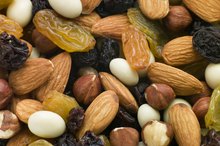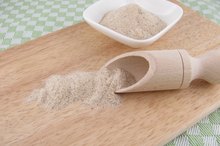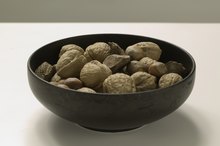What does fact checked mean?
At Healthfully, we strive to deliver objective content that is accurate and up-to-date. Our team periodically reviews articles in order to ensure content quality. The sources cited below consist of evidence from peer-reviewed journals, prominent medical organizations, academic associations, and government data.
The information contained on this site is for informational purposes only, and should not be used as a substitute for the advice of a professional health care provider. Please check with the appropriate physician regarding health questions and concerns. Although we strive to deliver accurate and up-to-date information, no guarantee to that effect is made.
Eating Peanuts & Diverticulitis
**Diverticular disease is common in Western societies and is believed to be primarily due to the relatively low-fiber diets the people eat.
** Diets low in fiber can lead to chronic constipation, which is thought to increase pressure in the colon and cause little pouches, called diverticula, to form.
The presence of these diverticula results in the condition called diverticulosis. Should bacteria or other matter become trapped in the diverticula, a painful infection called diverticulitis can occur. Diet is believed to play an important role in both the treatment and prevention of diverticulosis and diverticulitis.
Diverticulosis
If you have diverticulosis, you might experience cramping pain in the lower left abdomen, bloating and constipation. Many people with this condition, however, have no symptoms at all.
It is thought that including adequate fiber in your diet might help prevent diverticula from forming. A good goal is 20 to 35 g of dietary fiber every day. Eating fiber adds bulk to stools, pushing them through your colon more quickly.
This prevents constipation and the resulting increase in colon pressure, which might deter the formation of diverticula. Fiber also helps thicken stools, keeping the food particles bound together and making them less likely to become trapped in any existing diverticula. Preventing food particles from becoming trapped in diverticula can keep diverticulosis from developing into diverticulitis.
- If you have diverticulosis, you might experience cramping pain in the lower left abdomen, bloating and constipation.
- This prevents constipation and the resulting increase in colon pressure, which might deter the formation of diverticula.
High-Fiber Foods
Tortuous Colon Symptoms
Learn More
It's easy to obtain adequate fiber if you incorporate several high-fiber foods into your diet every day. The best dietary sources of fiber include whole-grain bread and pasta, brown rice, fresh fruits and vegetables, nuts -- including peanuts and tree nuts -- seeds and beans. Flaxseeds are a great source of fiber and can be added to many foods and baked goods. Whenever you eat grains, strive to make the majority of them whole grains. Look for the words "100% whole wheat" on food labels to ensure you are getting as much fiber as possible.
- It's easy to obtain adequate fiber if you incorporate several high-fiber foods into your diet every day.
- Whenever you eat grains, strive to make the majority of them whole grains.
Diverticulosis and Eating Nuts and Seeds
But this recommendation is not widely supported by current research.
Since nuts and seeds are rich sources of fiber, it is now believed they might actually play a role in the prevention of both diverticulosis and diverticulitis. To be safe and avoid the possibility of nuts and seeds becoming trapped in diverticula, it is best to chew these foods thoroughly, into the consistency of peanut butter, to minimize the risk of small particles entering your colon.
Diverticulitis
Do Some Foods Aggravate Diverticulitis?
Learn More
Nuts and seeds should, however, be avoided if you currently have diverticulitis. Diverticulitis is an acute state of inflammation and infection in your colon caused by bacteria or other irritants trapped in the diverticula.
If you have symptoms of diverticulitis, it is important to be evaluated by a medical doctor because treatment for this condition typically consists of antibiotics and bowel rest, which usually means consuming only water and other clear liquids. During the acute stage of diverticulitis, the main focus is on allowing your colon to rest and heal. The best way to do this is to avoid foods that add bulk to your stools, which are primarily those foods high in fiber. Consuming foods that are high in fiber during this acute inflammatory stage may aggravate symptoms, slow healing and lead to further complications. Once the inflammation begins to resolve, your diet is usually slowly advanced to a low-fiber diet, followed by the gradual reintroduction of high-fiber foods to prevent recurrent bouts of diverticulitis.
- Nuts and seeds should, however, be avoided if you currently have diverticulitis.
- During the acute stage of diverticulitis, the main focus is on allowing your colon to rest and heal.
Low-Fiber Foods
Foods that contain low amounts of fiber and may be consumed while your colon is healing include white or refined grains, such as white bread and white rice; soft or well-cooked fruits and vegetables without the skin or seeds; meats; eggs; and dairy products.
This low-fiber diet is considered "transitional," followed only until your symptoms resolve. Once you are no longer experiencing symptoms of diverticulitis, you may begin to gradually add fiber back into your diet. It is important to do so slowly, though, or gas, bloating and discomfort may result. Be sure to drink adequate amounts of fluid, at least 6 to 8 oz. of water daily, to prevent discomfort and constipation.
- Foods that contain low amounts of fiber and may be consumed while your colon is healing include white or refined grains, such as white bread and white rice; soft or well-cooked fruits and vegetables without the skin or seeds; meats; eggs; and dairy products.
- This low-fiber diet is considered "transitional," followed only until your symptoms resolve.
Related Articles
References
- Loffeld RJ. "Long-term follow-up and development of diverticulitis in patients diagnosed with diverticulosis of the colon." Int J Colorectal Dis. 2016 Jan;31:15-17. doi: 10.1007/s00384-015-2397-2391
- Peery AF, Keku TO, Martin CF, et al. "Distribution and characteristics of colonic diverticula in a United States screening population." Clinical Gastroenterology and Hepatology. 2016;7:980-985.
- Shahedi K, Fuller G, Bolus R, et al. "Long-term risk of acute diverticulitis among patients with incidental diverticulosis found during colonoscopy." Clinical Gastroenterology and Hepatology. 2013;11(12):1609–1613. doi: 10.1016/j.cgh.2013.06.020.
- Strate LL, Liu YL, Aldoori WH, Giovannucci EL. "Physical activity decreases diverticular complications.” Am J Gastroenterol. 2009 May;104(5):1221-30. doi: 10.1038/ajg.2009.121.
- Strate LL, Liu YL, Huang ES, Giovannucci EL, Chan AT. "Use of aspirin or nonsteroidal anti-inflammatory drugs increases risk for diverticulitis and diverticular bleeding.” Gastroenterology. 2011 May;140:1427-1433. doi: 10.1053/j.gastro.2011.02.004.
Writer Bio
Leah Wargolet graduated from the University of Wisconsin, Madison, with a Bachelor of Science in dietetics. She then completed her dietetic internship at California State University, Fresno, to become a registered dietitian. Wargolet recently completed her Master of Science in Physician Assistant Practice degree.









